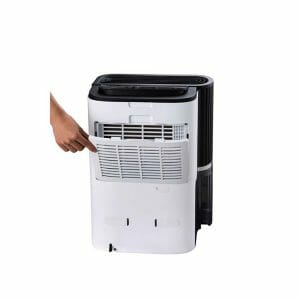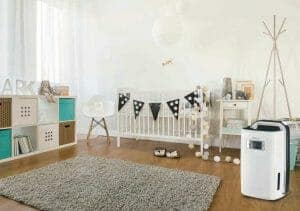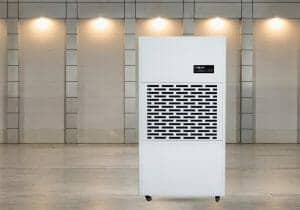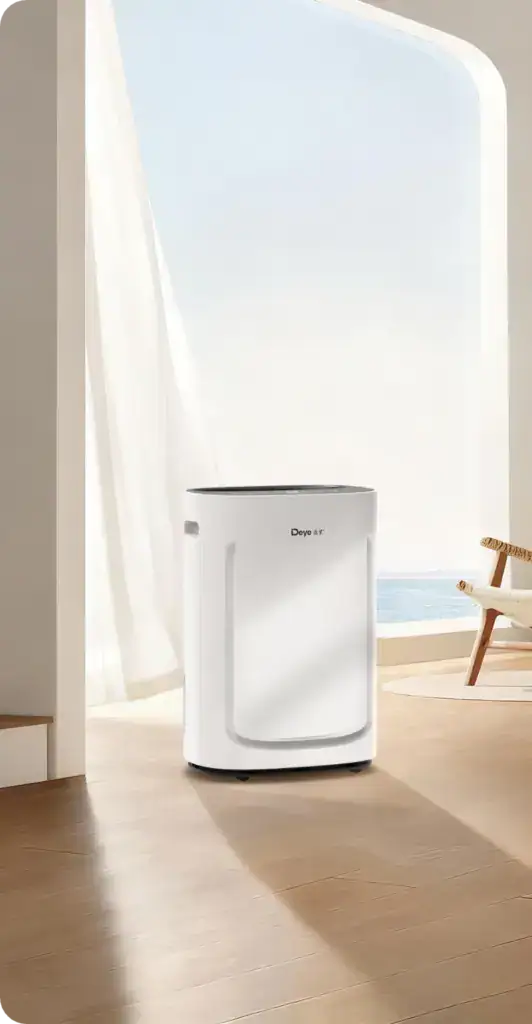Understand Dehumidifier
A Humid Environment is bad for your health and your home. Humid air creates comfortable surroundings for increasing pests and microorganisms, and vapor on your floor is unfriendly for your furniture, which means they are easy to damage. Your allergies and asthma can be aggravated by living in such an environment. If you are suffering from excessive humidity, a dehumidifier is a good choice for you。
Dehumidifiers are devices designed to reduce and maintain the level of humidity in the air. Humidity refers to the amount of water vapor present in the air.
Relative humidity (RH) is the percentage that measures air moisture. Your goal should be to keep RH between 30%-50%, as this range is generally recommended for indoor spaces. Above 50%, air can become a breeding ground for allergens.
Here’s a quick guide to when you might need to use a dehumidifier:
- Your room feels uncomfortably damp.
- You notice a musty smell, indicating mold or mildew presence.
- Water stains appear on walls or ceilings.
- Condensation forms on windows.
- The space has poor ventilation, particularly in areas like basements and bathrooms.
- The dehumidifier pulls in air containing water vapor.
- It then cools the air, causing the vapor to condense into water.
- This water is collected in a tank within the dehumidifier.
- The now-drier air is released back into the room.
Key Tips:
- Ensure at least 6-12 inches of clearance around the dehumidifier for optimal airflow.
- Keep doors and windows closed to maintain efficiency.
- Regularly empty the collected water to prevent overflow and ensure continuous operation.
By understanding and regulating humidity levels, you can improve your air quality and protect your home from moisture-related issues. Remember to monitor your space’s humidity and use a dehumidifier when necessary to maintain a comfortable, healthy living environment.
Benefits of Using a Dehumidifier

Dehumidifiers are key in maintaining optimal humidity levels in your home, contributing both to your well-being and the preservation of your home’s integrity. By controlling humidity, these devices offer several benefits that enhance your quality of life.
Prevent Mold and Mildew Growth
Maintaining a humidity level between 30-50% with a dehumidifier prevents the growth of mold and mildew. These fungi thrive in moist environments and can cause damage to walls, furniture, and clothing. By reducing excess moisture, you protect various surfaces in your home from these unwanted guests.
Improve Indoor Air Quality and Comfort
A dehumidifier can significantly improve your indoor air quality by reducing water vapor. This leads to fewer musty odors and greater overall comfort. With less humidity in your home, your living spaces feel cooler and more pleasant, which can be particularly beneficial in areas like basements and crawl spaces.
Protect Your Home from Damage
Excess humidity can lead to condensation, which may damage paint, wallpaper, and even the structural integrity of your home’s foundation and insulation. By using a dehumidifier, you safeguard these elements from moisture-related damage, ensuring the longevity of your home’s interior and structural components.
Enhance Energy Efficiency
Running a dehumidifier can make your home more energy-efficient. By removing moisture from the air, your HVAC system requires less energy to cool your home, potentially lowering your energy bill. This is especially true for units with Energy Star ratings, which are designed to be energy cost-effective.
Control Pests and Allergens
Damp environments attract pests such as silverfish and spiders, and can also harbor allergens like dust mites. A dehumidifier helps control the humidity in your home, making it less hospitable to these pests and reducing the presence of allergens. This can lead to a decrease in allergy symptoms and create a healthier indoor air environment for those with conditions like asthma.
Signs You Need a Dehumidifier
To maintain a comfortable and healthy home environment, it’s essential to manage indoor humidity levels effectively. Using a dehumidifier can help, especially in situations where moisture accumulates, leading to potential discomfort and health issues.
Recognizing Signs of High Moisture Levels
If your home feels consistently damp, or you notice a musty odor, these could be signs that the humidity levels are too high. Persistent window condensation, wet stains on walls and ceilings, and the presence of mold or mildew are other clear indicators. To measure your indoor humidity accurately, use a hygrometer to determine if levels exceed the ideal range of 30-50%.
Considering Seasons and Climate
Your need for a dehumidifier can depend heavily on the season and your local climate. High humidity is often a concern during the summer months when warmer temperatures hold more moisture in the air. Conversely, in winter, using a dehumidifier might still be necessary, especially in certain climates and if your home is particularly prone to dampness.
Assessing Home Areas and Situations
- Basements: Commonly have higher humidity levels due to their lower temperature and limited airflow.
- Bathrooms & Laundry Rooms: Frequent water use in these areas can lead to increased humidity.
- Crawlspaces & Kitchens: These spaces often trap moisture, which a dehumidifier can help alleviate.
- Bedrooms: For comfort and health, it’s essential to manage humidity where you sleep.
Remember, if any area in your home consistently feels damp, it’s smart to tackle the problem early with a dehumidifier to prevent discomfort and potential damage to your home.
How to Choose a Dehumidifier Suitable for You?
Selecting an appropriate dehumidifier is crucial for maintaining comfortable humidity levels in your home while minimizing energy costs. Understanding the types available, selecting the proper size, and considering essential features can ensure efficient moisture control.
Types of Dehumidifiers
Portable dehumidifiers are convenient for use in single rooms and are typically easier to install. On the other hand, whole-house dehumidifiers integrate with your home’s HVAC system to manage moisture throughout the entire living space. There are two main technologies: desiccant dehumidifiers, which use absorbent material to remove water from the air, and refrigerant dehumidifiers, which cool air to condense out moisture.
Sizing and Capacity Considerations
The capacity of a dehumidifier is its ability to remove moisture, measured in pints per day. To choose the right size for your room, consider the following:
- 500 sq. ft.: 10-pint capacity
- 1,000 sq. ft.: 14-pint capacity
- 1,500 sq. ft.: 18-pint capacity
For higher square footage or areas with excessive moisture, you may need larger units with higher pint capacities. The source of moisture and the room’s typical humidity levels should also be factors in your decision.
Cost
Portable Dehumidifiers
- Small capacity (20-30 pints): $45 – $260
- Medium capacity (35-50 pints): $139.99 – $299.99
- Large capacity (70-80 pints): $199.99 – $289.99
Whole-House/Basement Dehumidifiers
- Medium capacity (35-50 pints): $222 – $336
- Large capacity (70-80 pints): $229.99 – $269.99
It’s important to consider the appropriate capacity and features needed for the intended space when selecting a dehumidifier to get the best value for your needs and budget.
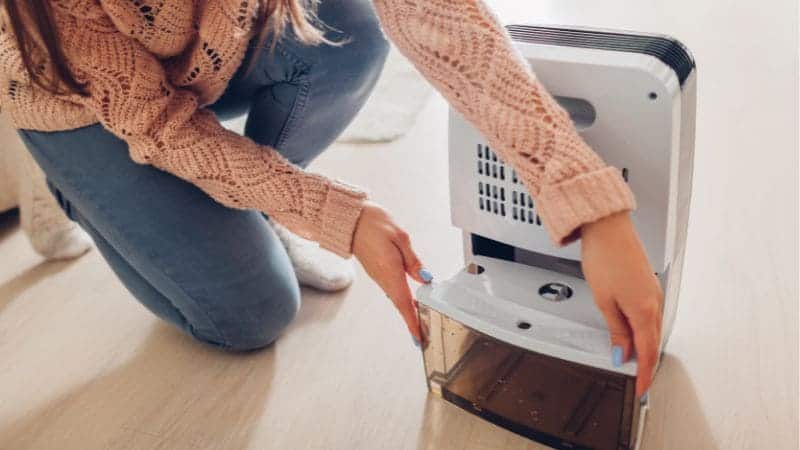
Features and Maintenance
Key features can include:
- Humidistat: To regulate and maintain desired humidity levels
- Automatic shutoff: For when the tank is full
- Filter indicators: To prompt cleaning or replacement
Regular maintenance, such as cleaning the filter and emptying the tank, will ensure your dehumidifier operates effectively and can help reduce future energy costs.
Operational Best Practices
Place your dehumidifier away from walls and furniture for proper ventilation, and make sure to remove excess distractions. Settings should be adjusted according to expert advice to optimally reduce indoor humidity levels, which are typically best kept below 50%. Proper placement and regular cleaning can also play significant roles in efficacy and energy savings.
By considering these aspects, you’ll be in a good position to keep your indoor air quality at a comfortable and healthy level.
Frequently Asked Questions
Do you need to use a dehumidifier every day?
You can use it every day if your room always has excess moisture. However, don’t leave it alone all day, and after 2-3 hours, you can turn off it for a while.
What is the best time to run a dehumidifier?
There is no exact answer for the best time to run a dehumidifier. If you find your room has higher humidity, you can turn it on at any time.
How often should I use the dehumidifier?
It depends on the humidity in your living areas. You can use it every day if you want, but not over 12 hours a day.
Is it bad to use a dehumidifier too much?
Yes, if you use a dehumidifier too much, the air will be too dry, and it is bad for your health and your home. Your skin will feel too dry and the floor is easy to crack

